Characteristics of the Fracture Process Zone for Reservoir Rock with Various Heterogeneity
Abstract
1. Introduction
2. Materials and Methods
2.1. Lithology, Texture Characteristics and Heterogeneity
2.2. Measurement Method of the FPZ Size
2.3. Measurement Methods of Tensile Strength and Mode I Fracture Toughness
2.4. Discrete Element Method (DEM) and Grain-Based Model
2.5. Model Setup and Parameter Calibration
3. Results
3.1. Tensile Strength, Fracture Toughness and FPZ Radius
3.2. Crack Morphology
3.3. Characteristics of the FPZ in DEM Models for the Marble
4. Discussion
4.1. Effects of Heterogeneity
4.2. Why the FPZ Size Depends on Rock Heterogeneity
4.3. Implications of the FPZ Size
5. Conclusions
Author Contributions
Funding
Data Availability Statement
Conflicts of Interest
References
- Lawn, B.R.; Wilshaw, T.R. Fracture of Brittle Solids; Cambridge University Press: New York, NY, USA, 1975. [Google Scholar]
- Liu, G.; Chen, Y.; Du, X.; Wang, S.; Fernández-Steeger, T.M. Evolutionary analysis of heterogeneous granite microcracks based on digital image processing in grain-block model. Materials 2022, 15, 1941. [Google Scholar] [CrossRef] [PubMed]
- Wang, Y.; Han, J.; Xia, Y.; Long, D. New insights into the fracture evolution and instability warning predication for fissure-contained hollow-cylinder granite with different hole diameter under multi-stage cyclic loads. Theor. Appl. Fract. Mech. 2022, 119, 103363. [Google Scholar] [CrossRef]
- Wang, Y.; Mao, T.; Xia, Y.; Li, X.; Yi, X. Macro-meso fatigue failure of bimrocks with various block content subjected to multistage fatigue triaxial loads. Int. J. Fatigue 2022, 163, 107014. [Google Scholar] [CrossRef]
- Lan, H.; Martin, C.D.; Hu, B. Effect of heterogeneity of brittle rock on micromechanical extensile behavior during compression loading. J. Geophys. Res. Solid Earth 2010, 115. [Google Scholar] [CrossRef]
- Shirole, D.; Walton, G.; Hedayat, A. Experimental investigation of multi-scale strain-field heterogeneity in rocks. Int. J. Rock Mech. Min. Sci. 2020, 127, 104212. [Google Scholar] [CrossRef]
- Atkinson, B.K. Fracture Mechanics of Rock; Academic Press: London, UK, 1987. [Google Scholar]
- Labuz, J.F.; Shah, S.P.; Dowding, C.H. Measurement and description of tensile fracture in granite. J. Eng. Mech. 1989, 115, 1935–1949. [Google Scholar] [CrossRef]
- Moazzami, M.; Ayatollahi, M.; Akhavan-Safar, A. Assessment of the fracture process zone in rocks using digital image correlation technique: The role of mode-mixity, size, geometry and material. Int. J. Damage Mech. 2020, 29, 646–666. [Google Scholar] [CrossRef]
- Zietlow, W.K.; Labuz, J.F. Measurement of the intrinsic process zone in rock using acoustic emission. Int. J. Rock Mech. Min. Sci. 1998, 35, 291–299. [Google Scholar] [CrossRef]
- Brooks, Z. Fracture Process Zone: Microstructure and Nanomechanics in Quasi-Brittle Materials. Ph.D. Thesis, Massachusetts Institute of Technology, Boston, MA, USA, 2013. [Google Scholar]
- Fakhimi, A.; Tarokh, A. Process zone and size effect in fracture testing of rock. Int. J. Rock Mech. Min. Sci. 2013, 60, 95–102. [Google Scholar] [CrossRef]
- Tarokh, A.; Makhnenko, R.Y.; Fakhimi, A.; Labuz, J.F. Scaling of the fracture process zone in rock. Int. J. Fract. 2017, 204, 191–204. [Google Scholar] [CrossRef]
- Haidar, K.; Pijaudier-Cabot, G.; Dubé, J.F.; Loukili, A. Correlation between the internal length, the fracture process zone and size effect in model materials. Mater. Struct. 2005, 38, 201–210. [Google Scholar] [CrossRef]
- Guha Roy, D.; Singh, T.N.; Kodikara, J. Influence of joint anisotropy on the fracturing behavior of a sedimentary rock. Eng. Geol. 2017, 228, 224–237. [Google Scholar] [CrossRef]
- Han, Z.; Zhou, J.; Zhang, L. Influence of grain size heterogeneity and in-situ stress on the hydraulic fracturing process by PFC2D modeling. Energies 2018, 11, 1413. [Google Scholar] [CrossRef]
- Tang, H.; Li, S.; Zhang, D. The effect of heterogeneity on hydraulic fracturing in shale. J. Pet. Sci. Eng. 2018, 162, 292–308. [Google Scholar] [CrossRef]
- Yang, T.H.; Tham, L.G.; Tang, C.A.; Liang, Z.Z.; Tsui, Y. Influence of heterogeneity of mechanical properties on hydraulic fracturing in permeable rocks. Rock Mech. Rock Eng. 2004, 37, 251–275. [Google Scholar] [CrossRef]
- Davraz, A.; Nalbantçılar, M.T.; Varol, S.; Önden, İ. Hydrogeochemistry and reservoir characterization of the Konya geothermal fields, Central Anatolia/Turkey. Geochemistry 2022, 82, 125867. [Google Scholar] [CrossRef]
- Gunes Yilmaz, N.; Karaca, Z.; Goktan, R.M.; Akal, C. Relative brittleness characterization of some selected granitic building stones: Influence of mineral grain size. Constr. Build. Mater. 2009, 23, 370–375. [Google Scholar] [CrossRef]
- Li, X.; Marasteanu, M. The fracture process zone in asphalt mixture at low temperature. Eng. Fract. Mech. 2010, 77, 1175–1190. [Google Scholar] [CrossRef]
- Spagnoli, A.; Carpinteri, A.; Ferretti, D.; Vantadori, S. An experimental investigation on the quasi-brittle fracture of marble rocks. Fatigue Fract. Eng. Mater. Struct. 2016, 39, 956–968. [Google Scholar] [CrossRef]
- Erarslan, N. Microstructural investigation of subcritical crack propagation and Fracture Process Zone (FPZ) by the reduction of rock fracture toughness under cyclic loading. Eng. Geol. 2016, 208, 181–190. [Google Scholar] [CrossRef]
- ISRM Commission on Standardization of Laboratory and Field Tests. Suggested methods for determining tensile strength of rock materials. Int. J. Rock Mech. Min. Sci. Geomech. Abstr. 1978, 15, 99–103. [Google Scholar] [CrossRef]
- ASTM D3967-16; Standard Test Method for Splitting Tensile Strength of Intact Rock Core Specimens. American Society of Testing Materials: West Conshohocken, PA, USA, 2016; pp. 1–5. [CrossRef]
- Kuruppu, M.D.; Obara, Y.; Ayatollahi, M.R.; Chong, K.P.; Funatsu, T. ISRM-suggested method for determining the Mode I static fracture toughness using semi-circular bend specimen. Rock Mech. Rock Eng. 2014, 47, 267–274. [Google Scholar] [CrossRef]
- ISRM Commission on Standardization of Laboratory and Field Tests. Suggested methods for determining the fracture-toughness of rock. Int. J. Rock Mech. Min. Sci. 1988, 25, 71–96. [Google Scholar] [CrossRef]
- Fowell, R.J.; Xu, C.; Dowd, P.A. An update on the fracture toughness testing methods related to the cracked chevron-notched Brazilian disk (CCNBD) specimen. Pure Appl. Geophys. 2006, 163, 1047–1057. [Google Scholar] [CrossRef]
- Potyondy, D.O.; Cundall, P.A. A bonded-particle model for rock. Int. J. Rock Mech. Min. Sci. 2004, 41, 1329–1364. [Google Scholar] [CrossRef]
- Nikolić, M.; Karavelić, E.; Ibrahimbegovic, A.; Miščević, P. Lattice element models and their peculiarities. Arch. Comput. Method Eng. 2018, 25, 753–784. [Google Scholar] [CrossRef]
- Potyondy, D.O. A grain-based model for rock: Approaching the true microstructure. In Proceedings of the Rock Mechanics in the Nordic Countries 2010, Kongsberg, Norway, 9–12 June 2010; pp. 225–234. [Google Scholar]
- Zhou, J.; Lan, H.; Zhang, L.; Yang, D.; Song, J.; Wang, S. Novel grain-based model for simulation of brittle failure of Alxa porphyritic granite. Eng. Geol. 2019, 251, 100–114. [Google Scholar] [CrossRef]
- Nikolic, M.; Ibrahimbegovic, A. Rock mechanics model capable of representing initial heterogeneities and full set of 3D failure mechanisms. Comput. Methods Appl. Mech. Eng. 2015, 290, 209–227. [Google Scholar] [CrossRef]
- Itasca Consulting Group Inc. PFC2D—Particle Flow Code in 2 Dimensions; Itasca Consulting Group Inc.: Minneapolis, MN, USA, 2019. [Google Scholar]
- Zhai, M.; Xue, L.; Bu, F.; Yang, B.; Ding, H. Microcracking behaviors and acoustic emission characteristics of granite subjected to direct shear based on a novel grain-based model. Comput. Geotech. 2022, 151, 104955. [Google Scholar] [CrossRef]
- Pierce, M.; Cundall, P.; Potyondy, D.; Ivars, D.M. A synthetic rock mass model for jointed rock. In Proceedings of the 1st Canada-U.S. Rock Mechanics Symposium, Vancouver, BC, Canada, 27–31 May 2007. [Google Scholar]
- Schön, J.H. Physical Properties of Rocks: Fundamentals and Principles of Petrophysics, 2nd ed.; Elsevier: Amsterdam, The Netherlands, 2015; Volume 65. [Google Scholar]
- Bahrani, N.; Kaiser, P.K.; Valley, B. Distinct element method simulation of an analogue for a highly interlocked, non-persistently jointed rockmass. Int. J. Rock Mech. Min. Sci. 2014, 71, 117–130. [Google Scholar] [CrossRef]
- Niu, J. Research on the Fracture Mechanics Index of Rock Fracability Evaluation. Ph.D. Thesis, University of Chinese Academy of Sciences, Beijing, China, 2015. [Google Scholar]
- Wong, L.N.Y.; Einstein, H.H. Crack coalescence in molded gypsum and Carrara marble: Part 2—Microscopic observations and interpretation. Rock Mech. Rock Eng. 2009, 42, 513–545. [Google Scholar] [CrossRef]
- Morgan, S.P.; Johnson, C.A.; Einstein, H.H. Cracking processes in Barre granite: Fracture process zones and crack coalescence. Int. J. Fract. 2013, 180, 177–204. [Google Scholar] [CrossRef]
- Cesano, D.; Bagtzoglou, A.C.; Olofsson, B. Quantifying fractured rock hydraulic heterogeneity and groundwater inflow prediction in underground excavations: The heterogeneity index. Tunn. Undergr. Space Technol. 2003, 18, 19–34. [Google Scholar] [CrossRef]
- Sabri, M.; Ghazvinian, A.; Nejati, H.R. Effect of particle size heterogeneity on fracture toughness and failure mechanism of rocks. Int. J. Rock Mech. Min. Sci. 2016, 81, 79–85. [Google Scholar] [CrossRef]
- Mahabadi, O.K.; Tatone, B.S.A.; Grasselli, G. Influence of microscale heterogeneity and microstructure on the tensile behavior of crystalline rocks. J. Geophys. Res. Solid Earth 2014, 119, 5324–5341. [Google Scholar] [CrossRef]
- Weibull, W. A statistical distribution function of wide applicability. J. Appl. Mech. 1951, 13, 293–297. [Google Scholar] [CrossRef]
- Tang, C.A.; Liu, H.; Lee, P.K.K.; Tsui, Y.; Tham, L.G. Numerical studies of the influence of microstructure on rock failure in uniaxial compression—Part I: Effect of heterogeneity. Int. J. Rock Mech. Min. Sci. 2000, 37, 555–569. [Google Scholar] [CrossRef]
- Liu, H.Y.; Roquete, M.; Kou, S.Q.; Lindqvist, P.A. Characterization of rock heterogeneity and numerical verification. Eng. Geol. 2004, 72, 89–119. [Google Scholar] [CrossRef]
- Zhu, W.; Tang, C.A. Micromechanical model for simulating the fracture process of rock. Rock Mech. Rock Eng. 2004, 37, 25–56. [Google Scholar] [CrossRef]
- Yang, B.C.; Qin, S.Q.; Xue, L.; Chen, H.R. The reasonable range limit of the shape parameter in the Weibull distribution for describing the brittle failure behavior of rocks. Rock Mech. Rock Eng. 2021, 54, 3359–3367. [Google Scholar] [CrossRef]
- Meng, F.; Wong, L.N.Y.; Zhou, H. Rock brittleness indices and their applications to different fields of rock engineering: A review. J. Rock Mech. Geotech. Eng. 2021, 13, 221–247. [Google Scholar] [CrossRef]
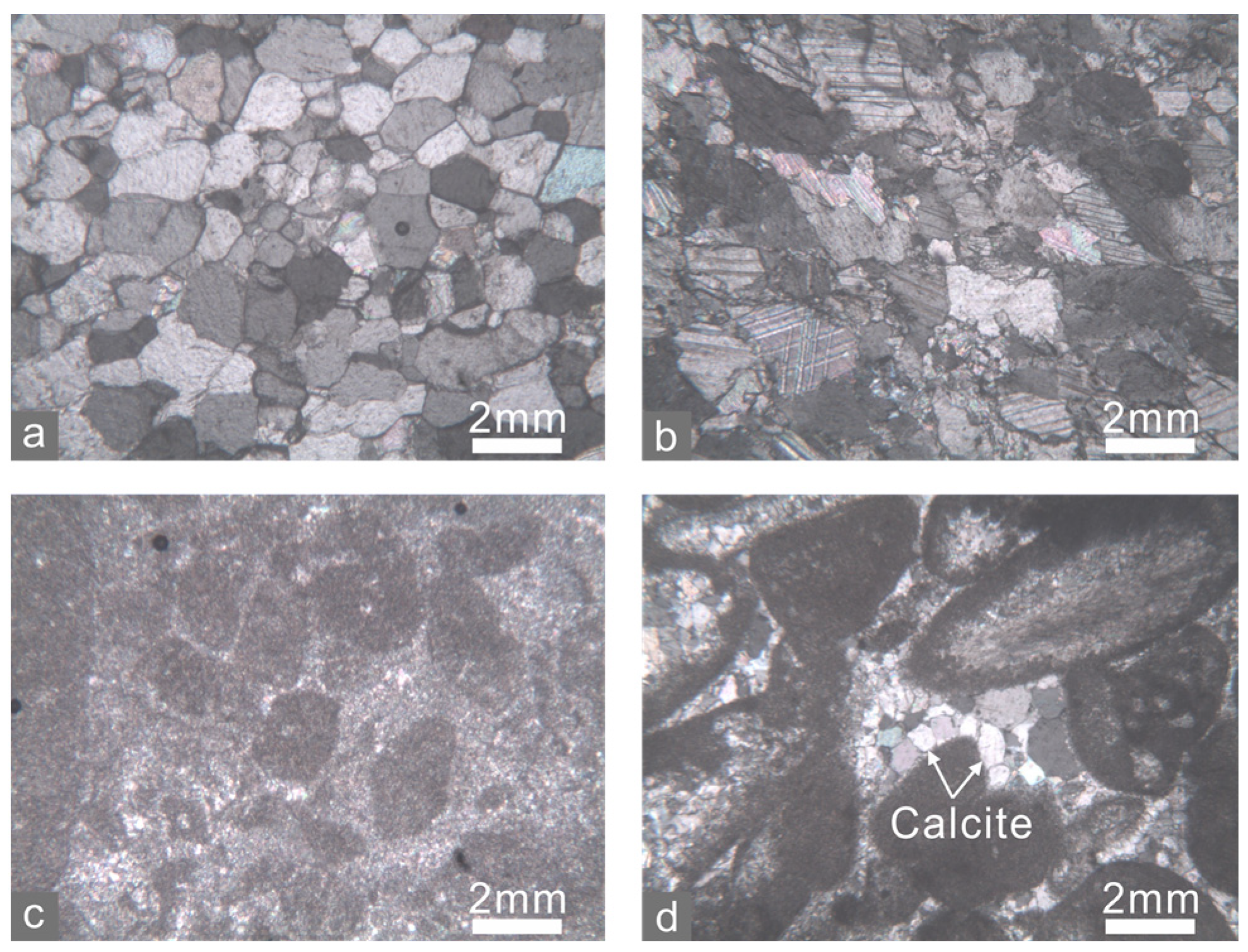
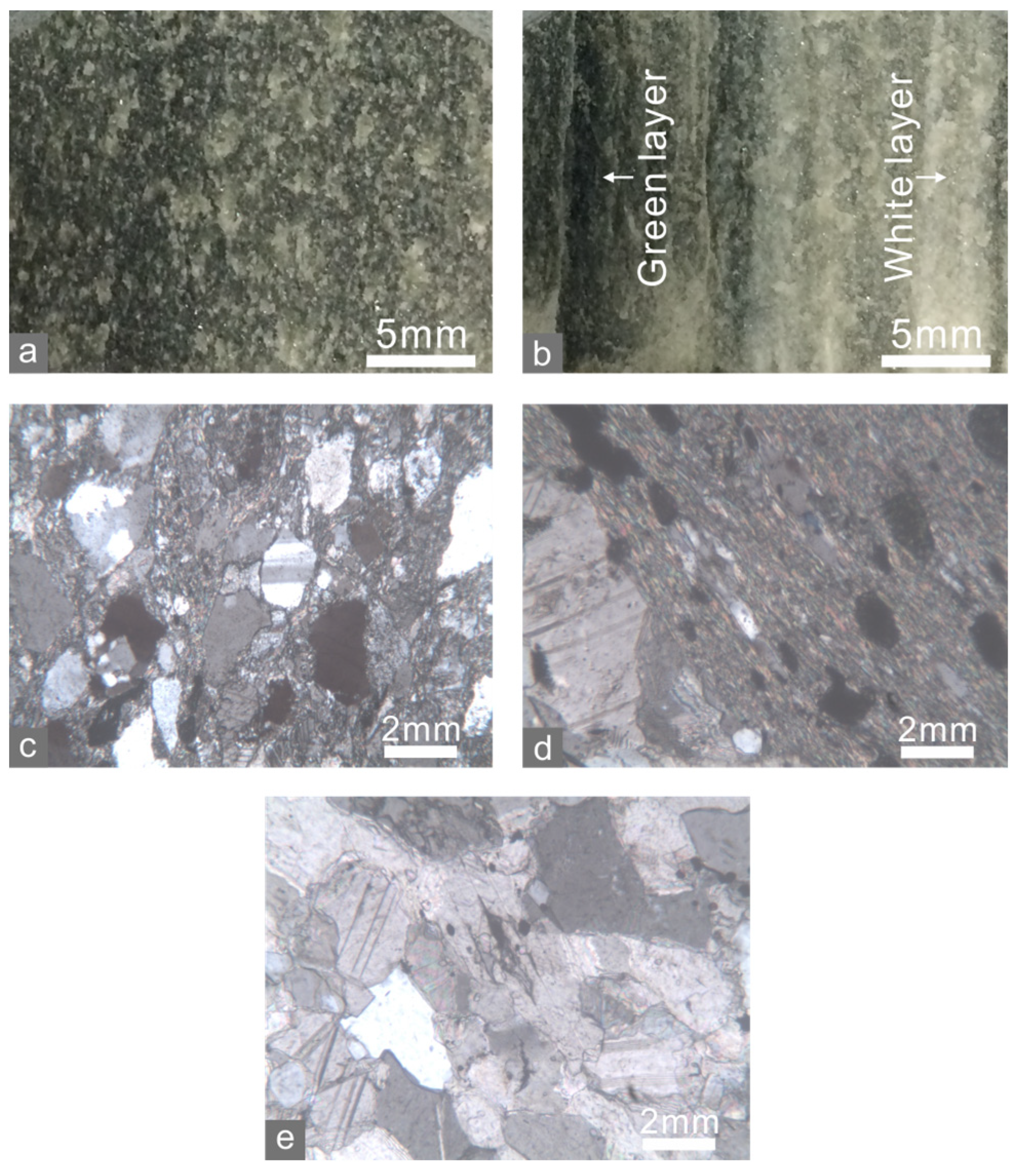
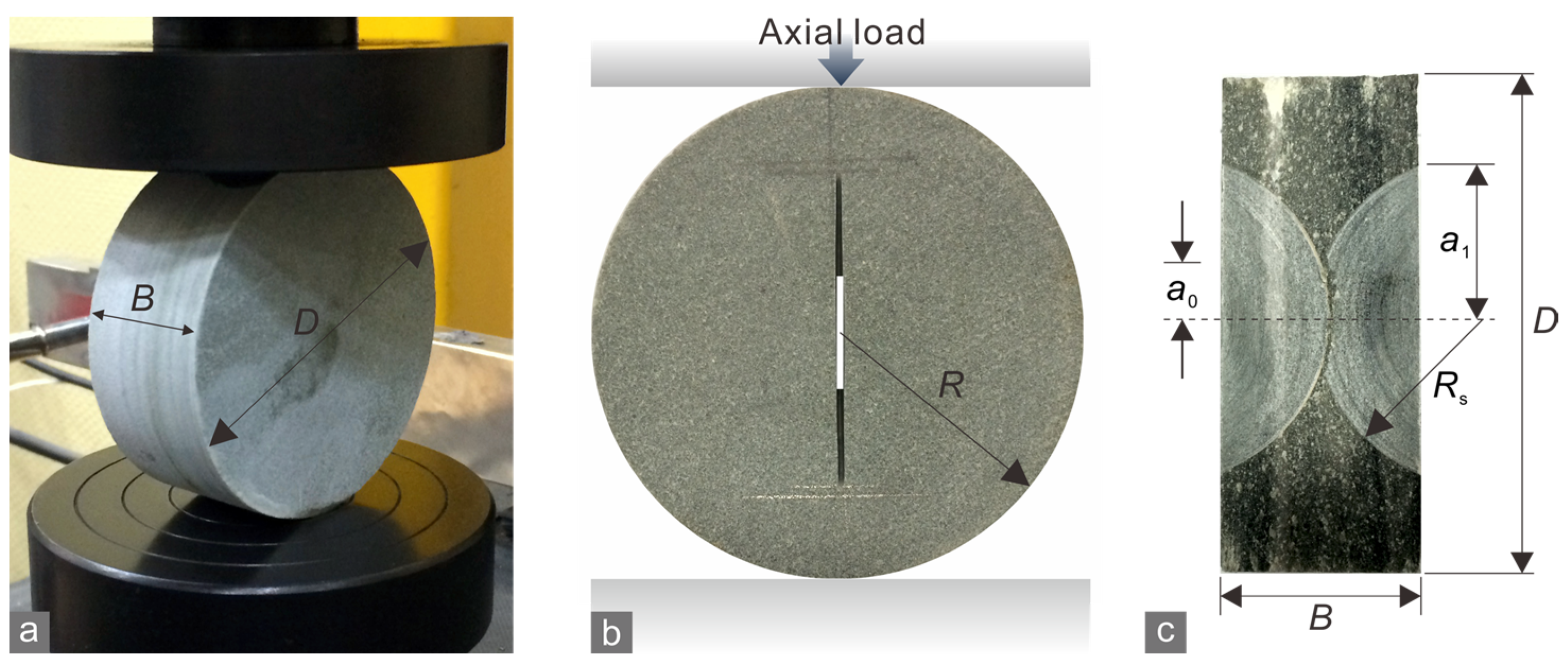


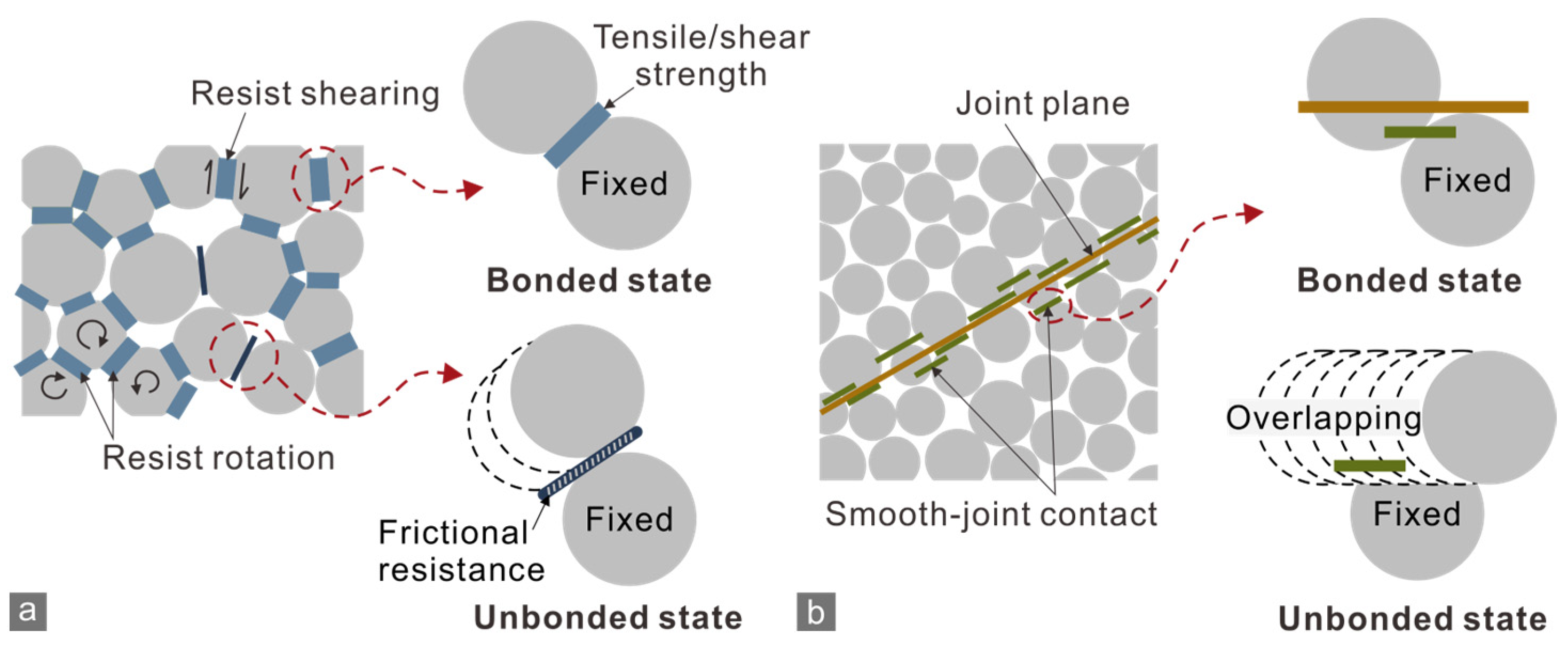


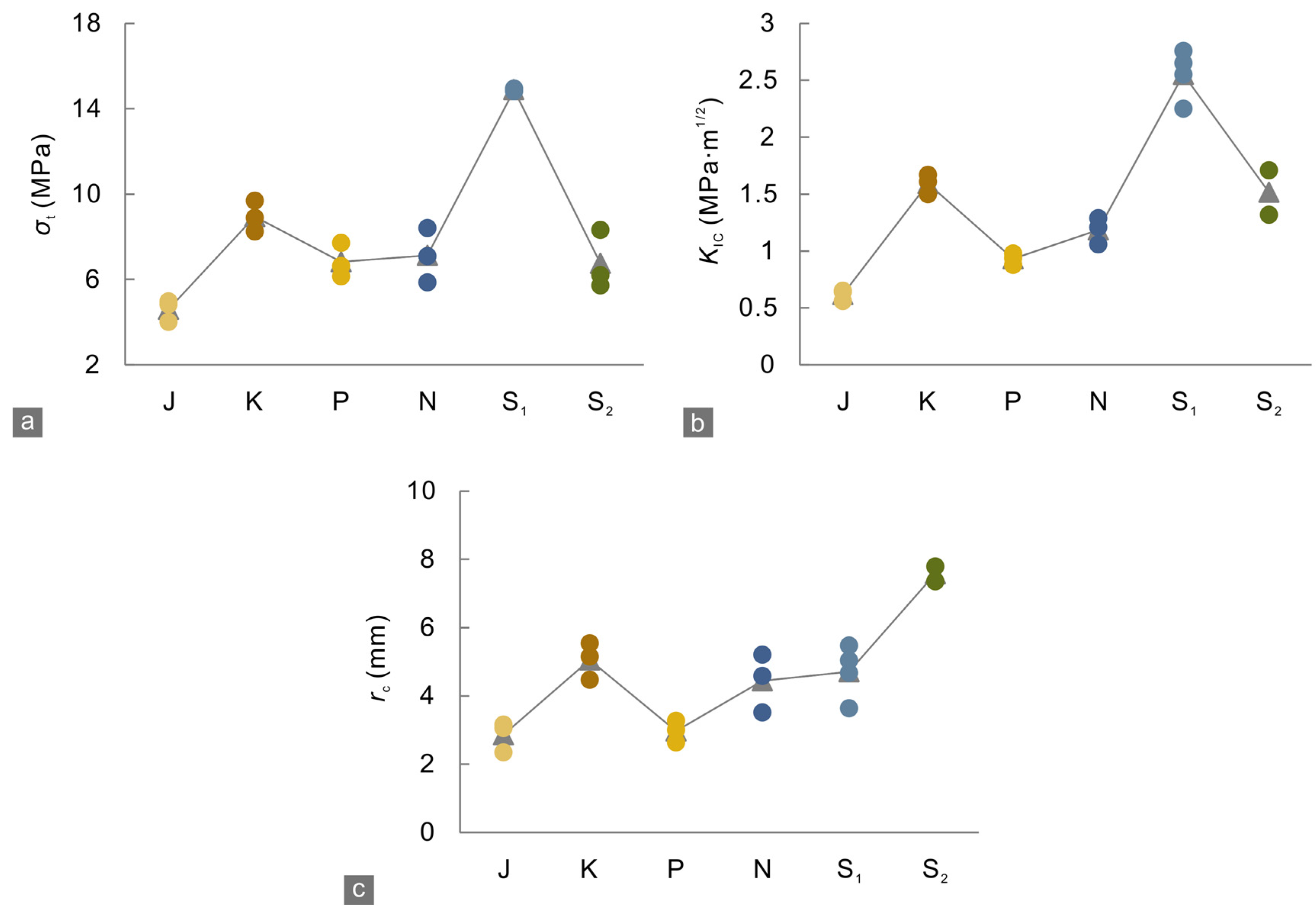
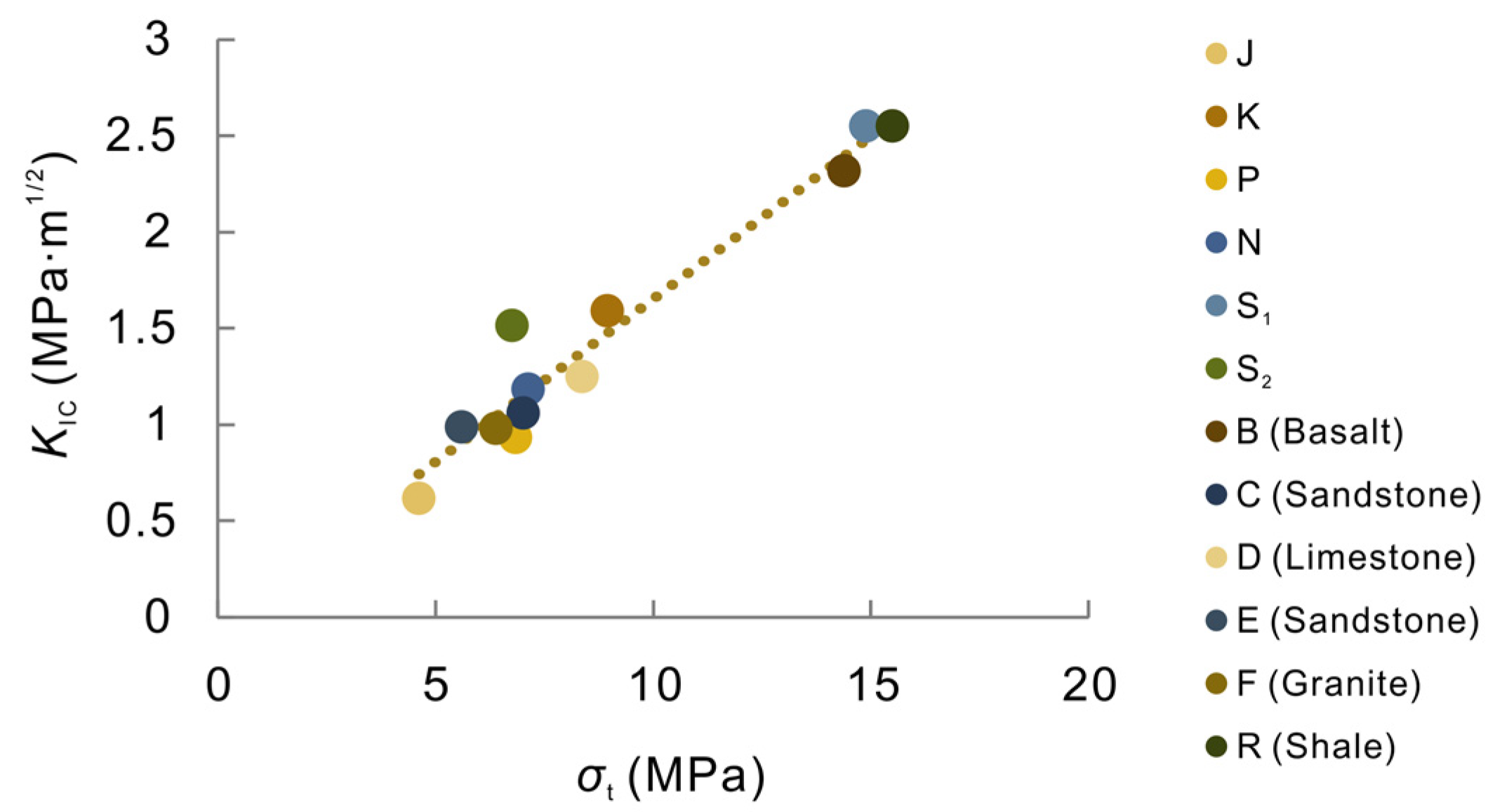
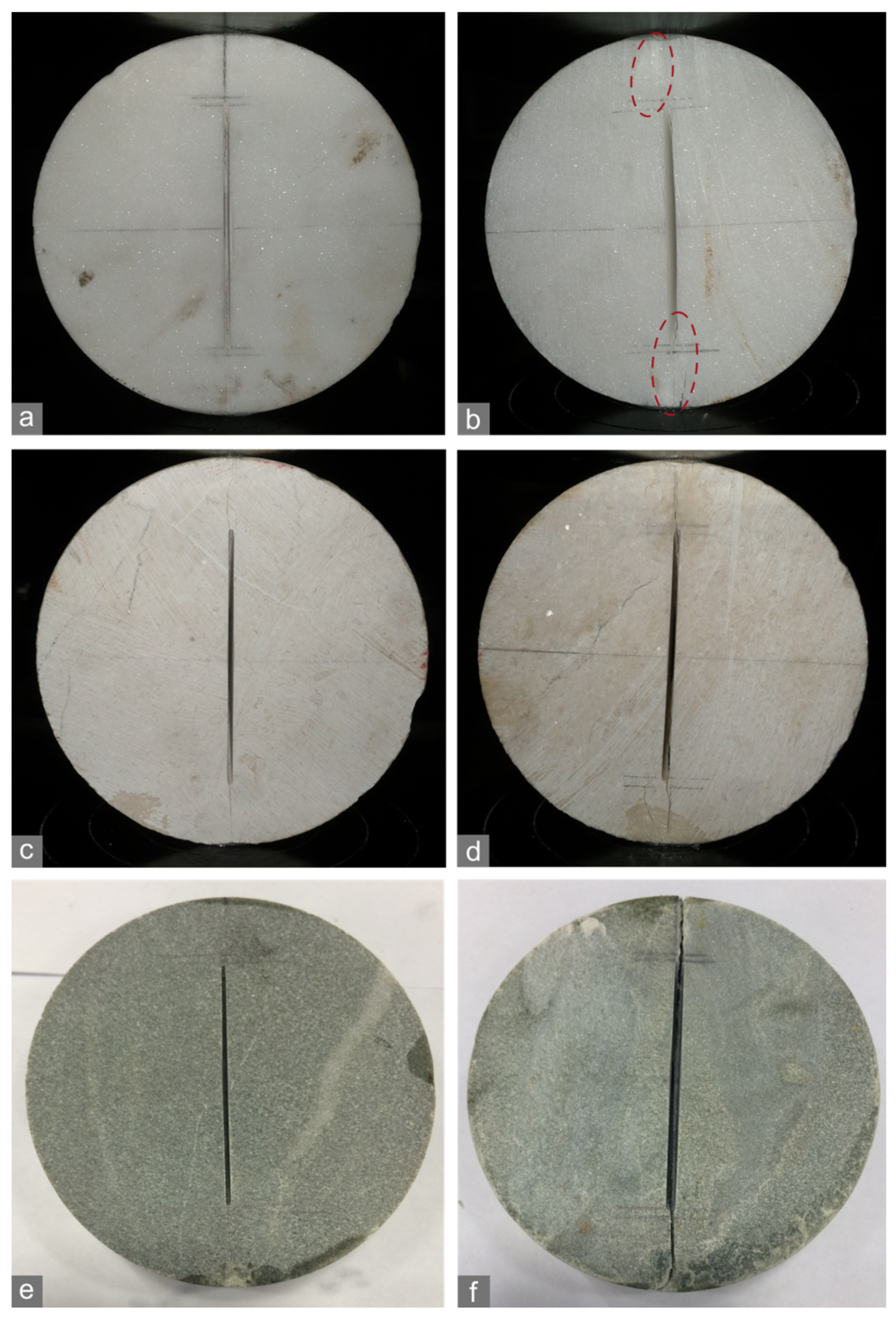
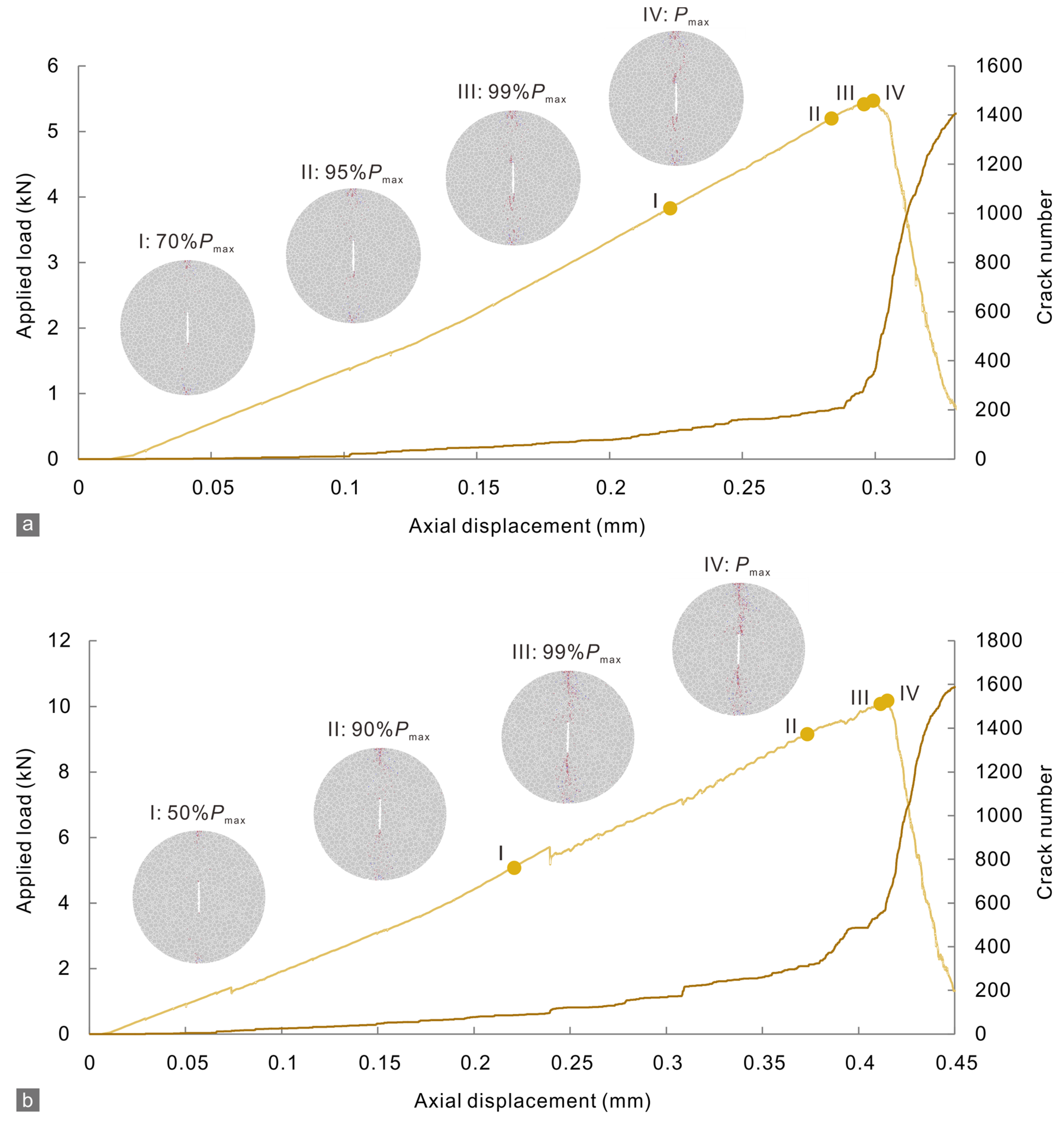
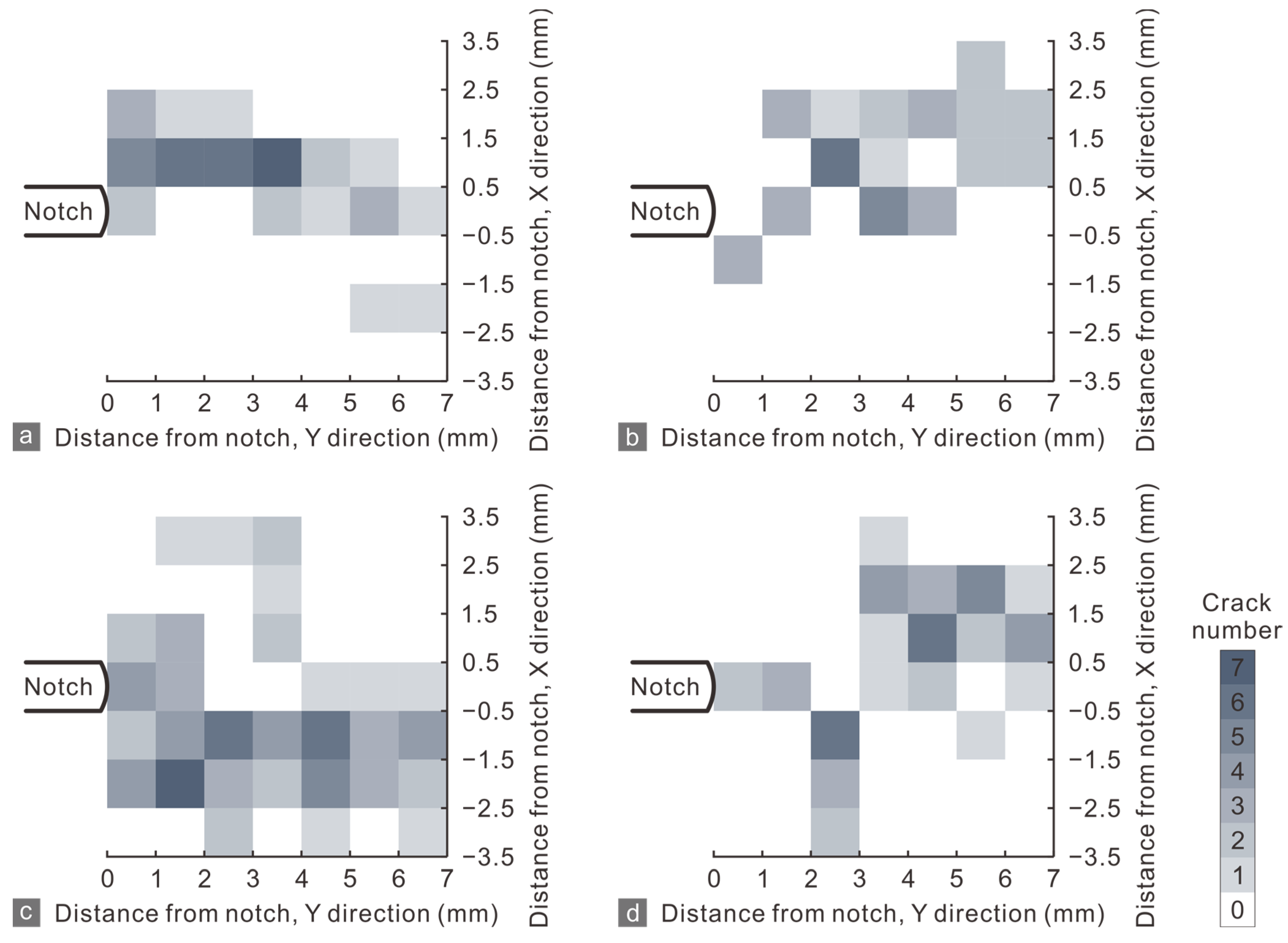
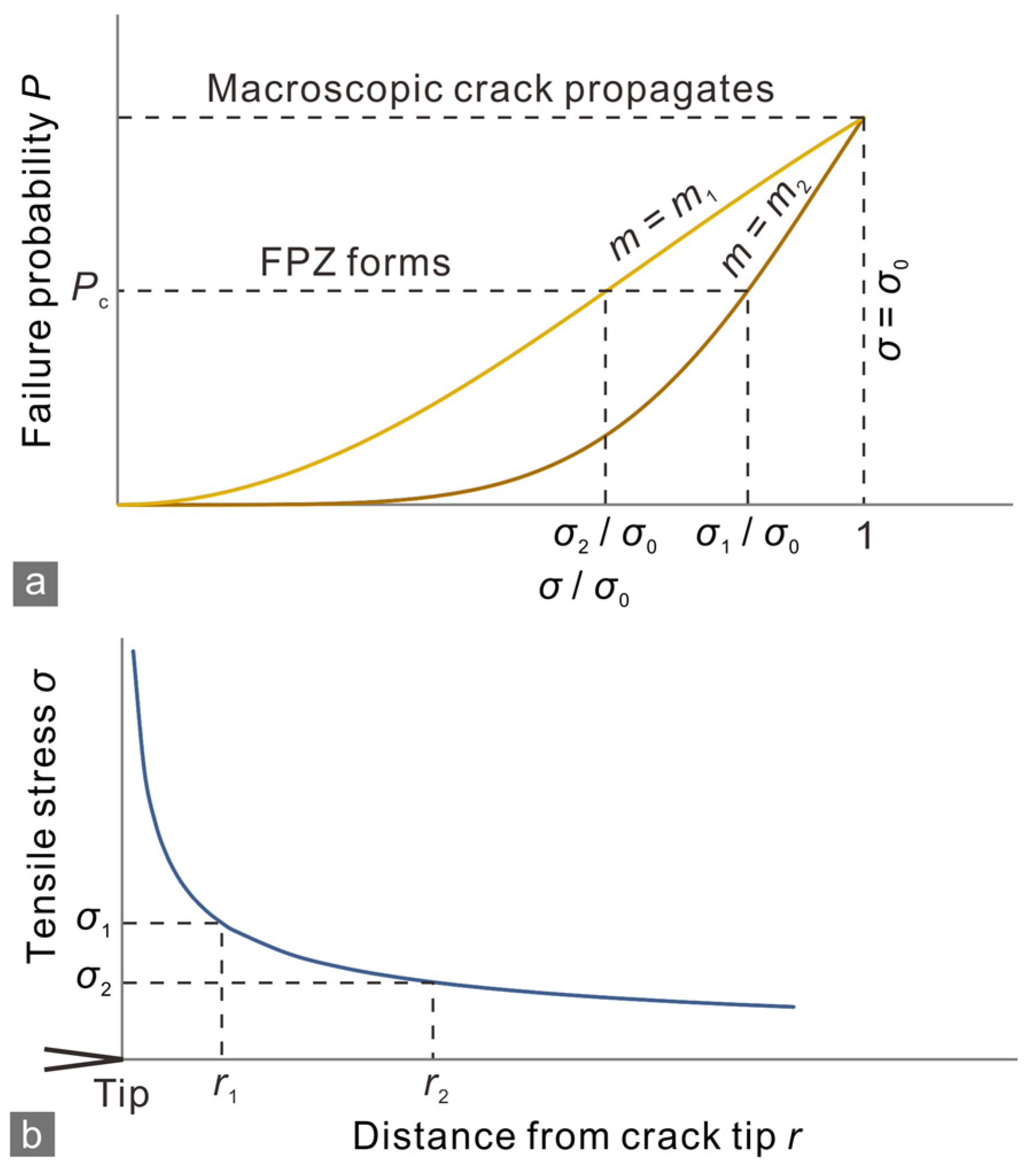
| Sample | Quartz (%) | Orthoclase (%) | Plagioclase (%) | Calcite (%) | Dolomite (%) | Clay (%) |
|---|---|---|---|---|---|---|
| J | / | / | / | 1.8 | 98.2 | / |
| K | / | / | / | 96.0 | 4.0 | / |
| P | / | / | / | 100.0 | / | / |
| N | / | / | / | 100.0 | / | / |
| S1 | 48.2 | / | 17.2 | 13.9 | / | 20.7 |
| S2 (green layer) | 19.9 | 1.5 | 4.1 | 55.3 | / | 19.2 |
| S2 (white layer) | 16.4 | / | / | 81.8 | / | 1.8 |
| Elements | Microscale Parameter | Marble J | Marble K |
|---|---|---|---|
| Particles | Density (kg/m3) | 2690 | 2690 |
| Effective modulus (GPa) | 70 | 70 | |
| Normal to shear stiffness ratio | 1.5 | 1.5 | |
| Friction coefficient | 0.6 | 0.6 | |
| Soft-bonded intra-grain contact | Effective modulus (GPa) | 10.0 | 15.0 |
| Normal to shear stiffness ratio | 2.0 | 2.0 | |
| Friction coefficient | 0.6 | 0.6 | |
| Tensile strength (MPa) | 18.0 | 37.5 | |
| Cohesion (MPa) | 72.0 | 150.0 | |
| Friction angle (°) | 45.0 | 45.0 | |
| Softening factor | 0.1 | 0.1 | |
| Softening tensile strength factor | 0.7 | 0.7 | |
| Smooth-joint inter-grain contact | Tensile strength coefficient | 0.3 | 0.3 |
| Cohesion coefficient | 0.8 | 0.8 | |
| Friction angle coefficient | 0.6 | 0.6 | |
| Friction adjustment coefficient | 0.5 | 0.5 | |
| Normal stiffness coefficient | 0.8 | 0.8 | |
| Shear stiffness coefficient | 0.15 | 0.15 |
Publisher’s Note: MDPI stays neutral with regard to jurisdictional claims in published maps and institutional affiliations. |
© 2022 by the authors. Licensee MDPI, Basel, Switzerland. This article is an open access article distributed under the terms and conditions of the Creative Commons Attribution (CC BY) license (https://creativecommons.org/licenses/by/4.0/).
Share and Cite
Chen, H.; Niu, J.; Zhai, M. Characteristics of the Fracture Process Zone for Reservoir Rock with Various Heterogeneity. Energies 2022, 15, 8332. https://doi.org/10.3390/en15228332
Chen H, Niu J, Zhai M. Characteristics of the Fracture Process Zone for Reservoir Rock with Various Heterogeneity. Energies. 2022; 15(22):8332. https://doi.org/10.3390/en15228332
Chicago/Turabian StyleChen, Hongran, Jingrui Niu, and Mengyang Zhai. 2022. "Characteristics of the Fracture Process Zone for Reservoir Rock with Various Heterogeneity" Energies 15, no. 22: 8332. https://doi.org/10.3390/en15228332
APA StyleChen, H., Niu, J., & Zhai, M. (2022). Characteristics of the Fracture Process Zone for Reservoir Rock with Various Heterogeneity. Energies, 15(22), 8332. https://doi.org/10.3390/en15228332







